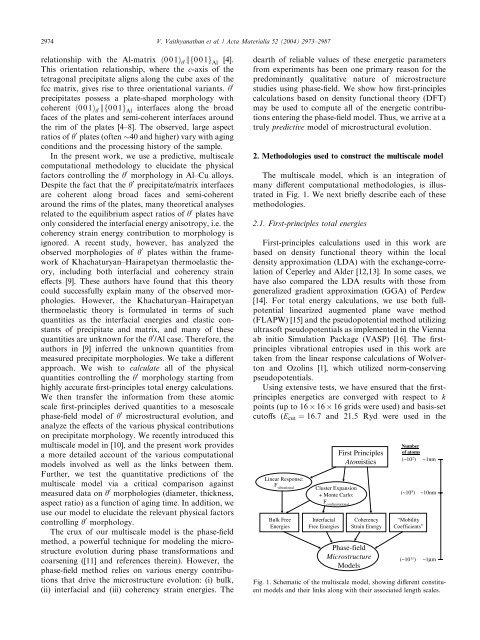Multiscale Modeling of Theta ' Precipitation in Al-Cu Binary Alloys
Multiscale Modeling of Theta ' Precipitation in Al-Cu Binary Alloys
Multiscale Modeling of Theta ' Precipitation in Al-Cu Binary Alloys
Create successful ePaper yourself
Turn your PDF publications into a flip-book with our unique Google optimized e-Paper software.
2974 V. Vaithyanathan et al. / Acta Materialia 52 (2004) 2973–2987<br />
relationship with the <strong>Al</strong>-matrix ð001Þ h<br />
0kf001g <strong>Al</strong> [4].<br />
This orientation relationship, where the c-axis <strong>of</strong> the<br />
tetragonal precipitate aligns along the cube axes <strong>of</strong> the<br />
fcc matrix, gives rise to three orientational variants. h 0<br />
precipitates possess a plate-shaped morphology with<br />
coherent ð001Þ h<br />
0kf001g <strong>Al</strong> <strong>in</strong>terfaces along the broad<br />
faces <strong>of</strong> the plates and semi-coherent <strong>in</strong>terfaces around<br />
the rim <strong>of</strong> the plates [4–8]. The observed, large aspect<br />
ratios <strong>of</strong> h 0 plates (<strong>of</strong>ten 40 and higher) vary with ag<strong>in</strong>g<br />
conditions and the process<strong>in</strong>g history <strong>of</strong> the sample.<br />
In the present work, we use a predictive, multiscale<br />
computational methodology to elucidate the physical<br />
factors controll<strong>in</strong>g the h 0 morphology <strong>in</strong> <strong>Al</strong>–<strong>Cu</strong> alloys.<br />
Despite the fact that the h 0 precipitate/matrix <strong>in</strong>terfaces<br />
are coherent along broad faces and semi-coherent<br />
around the rims <strong>of</strong> the plates, many theoretical analyses<br />
related to the equilibrium aspect ratios <strong>of</strong> h 0 plates have<br />
only considered the <strong>in</strong>terfacial energy anisotropy, i.e. the<br />
coherency stra<strong>in</strong> energy contribution to morphology is<br />
ignored. A recent study, however, has analyzed the<br />
observed morphologies <strong>of</strong> h 0 plates with<strong>in</strong> the framework<br />
<strong>of</strong> Khachaturyan–Hairapetyan thermoelastic theory,<br />
<strong>in</strong>clud<strong>in</strong>g both <strong>in</strong>terfacial and coherency stra<strong>in</strong><br />
effects [9]. These authors have found that this theory<br />
could successfully expla<strong>in</strong> many <strong>of</strong> the observed morphologies.<br />
However, the Khachaturyan–Hairapetyan<br />
thermoelastic theory is formulated <strong>in</strong> terms <strong>of</strong> such<br />
quantities as the <strong>in</strong>terfacial energies and elastic constants<br />
<strong>of</strong> precipitate and matrix, and many <strong>of</strong> these<br />
quantities are unknown for the h 0 /<strong>Al</strong> case. Therefore, the<br />
authors <strong>in</strong> [9] <strong>in</strong>ferred the unknown quantities from<br />
measured precipitate morphologies. We take a different<br />
approach. We wish to calculate all <strong>of</strong> the physical<br />
quantities controll<strong>in</strong>g the h 0 morphology start<strong>in</strong>g from<br />
highly accurate first-pr<strong>in</strong>ciples total energy calculations.<br />
We then transfer the <strong>in</strong>formation from these atomic<br />
scale first-pr<strong>in</strong>ciples derived quantities to a mesoscale<br />
phase-field model <strong>of</strong> h 0 microstructural evolution, and<br />
analyze the effects <strong>of</strong> the various physical contributions<br />
on precipitate morphology. We recently <strong>in</strong>troduced this<br />
multiscale model <strong>in</strong> [10], and the present work provides<br />
a more detailed account <strong>of</strong> the various computational<br />
models <strong>in</strong>volved as well as the l<strong>in</strong>ks between them.<br />
Further, we test the quantitative predictions <strong>of</strong> the<br />
multiscale model via a critical comparison aga<strong>in</strong>st<br />
measured data on h 0 morphologies (diameter, thickness,<br />
aspect ratio) as a function <strong>of</strong> ag<strong>in</strong>g time. In addition, we<br />
use our model to elucidate the relevant physical factors<br />
controll<strong>in</strong>g h 0 morphology.<br />
The crux <strong>of</strong> our multiscale model is the phase-field<br />
method, a powerful technique for model<strong>in</strong>g the microstructure<br />
evolution dur<strong>in</strong>g phase transformations and<br />
coarsen<strong>in</strong>g ([11] and references there<strong>in</strong>). However, the<br />
phase-field method relies on various energy contributions<br />
that drive the microstructure evolution: (i) bulk,<br />
(ii) <strong>in</strong>terfacial and (iii) coherency stra<strong>in</strong> energies. The<br />
dearth <strong>of</strong> reliable values <strong>of</strong> these energetic parameters<br />
from experiments has been one primary reason for the<br />
predom<strong>in</strong>antly qualitative nature <strong>of</strong> microstructure<br />
studies us<strong>in</strong>g phase-field. We show how first-pr<strong>in</strong>ciples<br />
calculations based on density functional theory (DFT)<br />
may be used to compute all <strong>of</strong> the energetic contributions<br />
enter<strong>in</strong>g the phase-field model. Thus, we arrive at a<br />
truly predictive model <strong>of</strong> microstructural evolution.<br />
2. Methodologies used to construct the multiscale model<br />
The multiscale model, which is an <strong>in</strong>tegration <strong>of</strong><br />
many different computational methodologies, is illustrated<br />
<strong>in</strong> Fig. 1. We next briefly describe each <strong>of</strong> these<br />
methodologies.<br />
2.1. First-pr<strong>in</strong>ciples total energies<br />
First-pr<strong>in</strong>ciples calculations used <strong>in</strong> this work are<br />
based on density functional theory with<strong>in</strong> the local<br />
density approximation (LDA) with the exchange-correlation<br />
<strong>of</strong> Ceperley and <strong>Al</strong>der [12,13]. In some cases, we<br />
have also compared the LDA results with those from<br />
generalized gradient approximation (GGA) <strong>of</strong> Perdew<br />
[14]. For total energy calculations, we use both fullpotential<br />
l<strong>in</strong>earized augmented plane wave method<br />
(FLAPW) [15] and the pseudopotential method utiliz<strong>in</strong>g<br />
ultras<strong>of</strong>t pseudopotentials as implemented <strong>in</strong> the Vienna<br />
ab <strong>in</strong>itio Simulation Package (VASP) [16]. The firstpr<strong>in</strong>ciples<br />
vibrational entropies used <strong>in</strong> this work are<br />
taken from the l<strong>in</strong>ear response calculations <strong>of</strong> Wolverton<br />
and Ozol<strong>in</strong>s [1], which utilized norm-conserv<strong>in</strong>g<br />
pseudopotentials.<br />
Us<strong>in</strong>g extensive tests, we have ensured that the firstpr<strong>in</strong>ciples<br />
energetics are converged with respect to k<br />
po<strong>in</strong>ts (up to 16 16 16 grids were used) and basis-set<br />
cut<strong>of</strong>fs (E cut ¼ 16:7 and 21.5 Ryd were used <strong>in</strong> the<br />
L<strong>in</strong>ear Response:<br />
F vibrational<br />
Bulk Free<br />
Energies<br />
Cluster Expansion<br />
+ Monte Carlo:<br />
F configurational<br />
Interfacial<br />
Free Energies<br />
First Pr<strong>in</strong>ciples<br />
Atomistics<br />
Coherency<br />
Stra<strong>in</strong> Energy<br />
Phase-field<br />
Microstructure<br />
Models<br />
Number<br />
<strong>of</strong> atoms<br />
(~10 2 ) ~1nm<br />
(~10 5 ) ~10nm<br />
“Mobility<br />
Coefficients”<br />
(~10 11 ) ~1µm<br />
Fig. 1. Schematic <strong>of</strong> the multiscale model, show<strong>in</strong>g different constituent<br />
models and their l<strong>in</strong>ks along with their associated length scales.
















